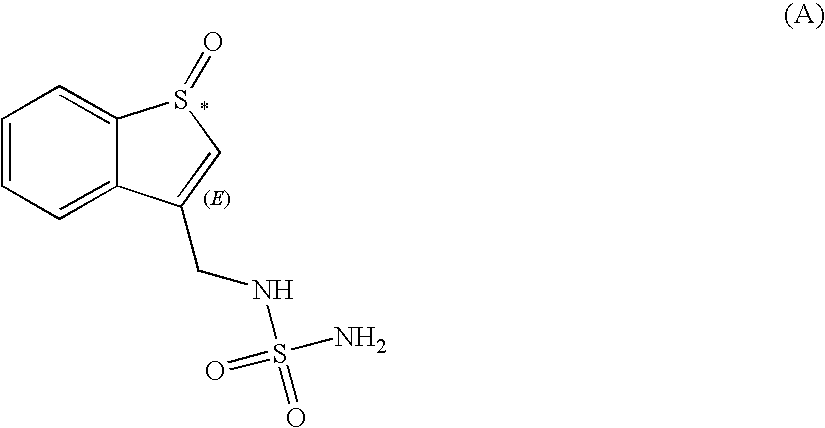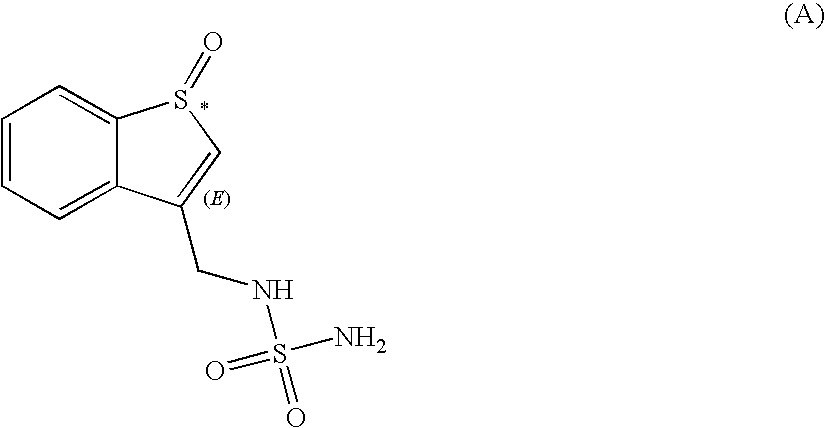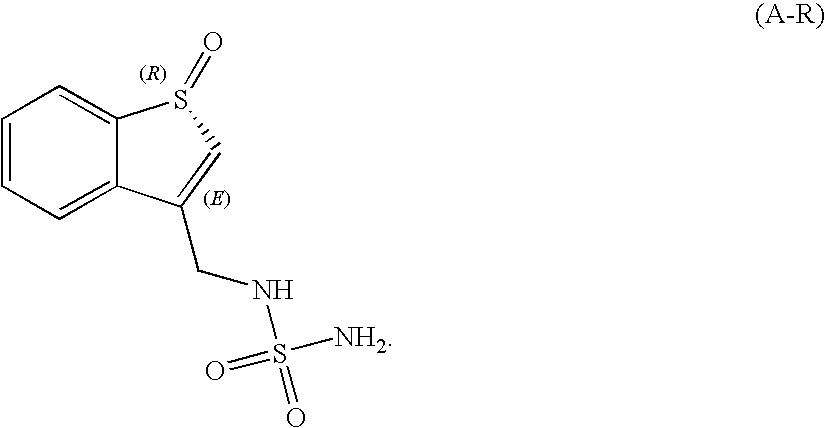Sulfamide derivative useful for the treatment of epilepsy
a technology of sulfamide and derivatives, applied in the field of sulfamide derivatives, can solve the problems of partial airway obstruction and severe breathing
- Summary
- Abstract
- Description
- Claims
- Application Information
AI Technical Summary
Problems solved by technology
Method used
Image
Examples
example 1
Preparation of the Compound of Formula (A)
[0079]
[0080]A 1-L 3-neck round bottom flask equipped with a magnetic stirrer, a thermocouple, a septum and nitrogen inlet adapter was charged with N-(benzo[b]thien-3-ylmethyl)-sulfamide (16.0 g, 66.03 mmol), dichloromethane (140 mL), and trifluoroacetic acid (100 mL; 1.31 mol) at 20° C. The resulting mixture was stirred for 5 min at 10° C., then hydrogen peroxide (6.2 mL; 70.49 mmol) was added dropwise over 2 min, and the reaction mixture stirred for 5 h while the reaction temperature was maintained between 8-10° C. in a cold water bath with addition of ice. Additional hydrogen peroxide (0.6 mL, 0.096 eq.) was added, and the reaction mixture was stirred for an additional hour at 10° C. A 1.5 M solution of sodium sulfite (2 mL; 3.00 mmol) was added at 0° C. and the resulting mixture stirred for 10 min. The solvents were removed in vacuo at 50° C., the resulting material was chased with methanol (30 mL×2) to yield the title compound as a yello...
example 2
Preparation of the Compound of Formula (A)
[0083]
[0084]N-(benzo[b]thien-3-ylmethyl)-sulfamide (25 g, 103.17 mmol) was placed in a 1 L round-bottomed flask together with dichloromethane (175 mL, 2.73 moles) and trifluoroacetic acid (100 mL, 1.32 moles). Hydrogen peroxide (35 wt % in water; 10 mL, 114.52 mmol) was added to the resulting solution and the mixture stirred at room temperature for 3.5 h. The reaction was monitored by Thin Layer Chromatography (TLC) on silica gel plates using CH2Cl2 / methanol (96:4) as eluent. The reaction mixture was treated with an aqueous solution Na2SO3 (1.5M; 3.75 mL, 0.05 equivalents) and the resulting mixture stirred for 15 min. The solvent was evaporated under reduced pressure at a temperature of 30° C. or lower to yield an oily residue. The residue was dissolved in CH2Cl2 (150 mL) and stirred at room temperature. Ethyl acetate (150 mL) was added slowly over about 2 h with stirring; a yellowish white solid precipitated during the addition. The resulti...
example 3
[0085]Chiral Separation of Compound of Formula (A) Racemate into Component Enantiomers
[0086]An analytical enantioselective chromatographic method was developed for the separation of the enantiomers of N-[(1-oxidobenzo[b]thien-3-yl)methyl]-sulfamide. Stationary phase Chiralpak ADH with methanol as a mobile phase was selected. Racemic compound was injected on a preparative enantioselective chromatographic column in methanol solution. Automated injections and collection cycles were repeated until the entire amount of the racemate was processed. Fractions containing individual enantiomers were collected during separation and evaporated to dryness.
[0087]When running the chromatographic separation, a low temperature of evaporation (5° C.) and a high vacuum (10 mbar), with temperature of the condenser set at −60° C. yielded single enantiomers with enantiomeric purity >95 ee and residual methanol content <1%. Absolute configuration of the single enantiomers was not determined.
[0088]Racemic ...
PUM
| Property | Measurement | Unit |
|---|---|---|
| enantiomeric excess | aaaaa | aaaaa |
| enantiomeric excess | aaaaa | aaaaa |
| enantiomeric excess | aaaaa | aaaaa |
Abstract
Description
Claims
Application Information
 Login to View More
Login to View More - R&D
- Intellectual Property
- Life Sciences
- Materials
- Tech Scout
- Unparalleled Data Quality
- Higher Quality Content
- 60% Fewer Hallucinations
Browse by: Latest US Patents, China's latest patents, Technical Efficacy Thesaurus, Application Domain, Technology Topic, Popular Technical Reports.
© 2025 PatSnap. All rights reserved.Legal|Privacy policy|Modern Slavery Act Transparency Statement|Sitemap|About US| Contact US: help@patsnap.com



